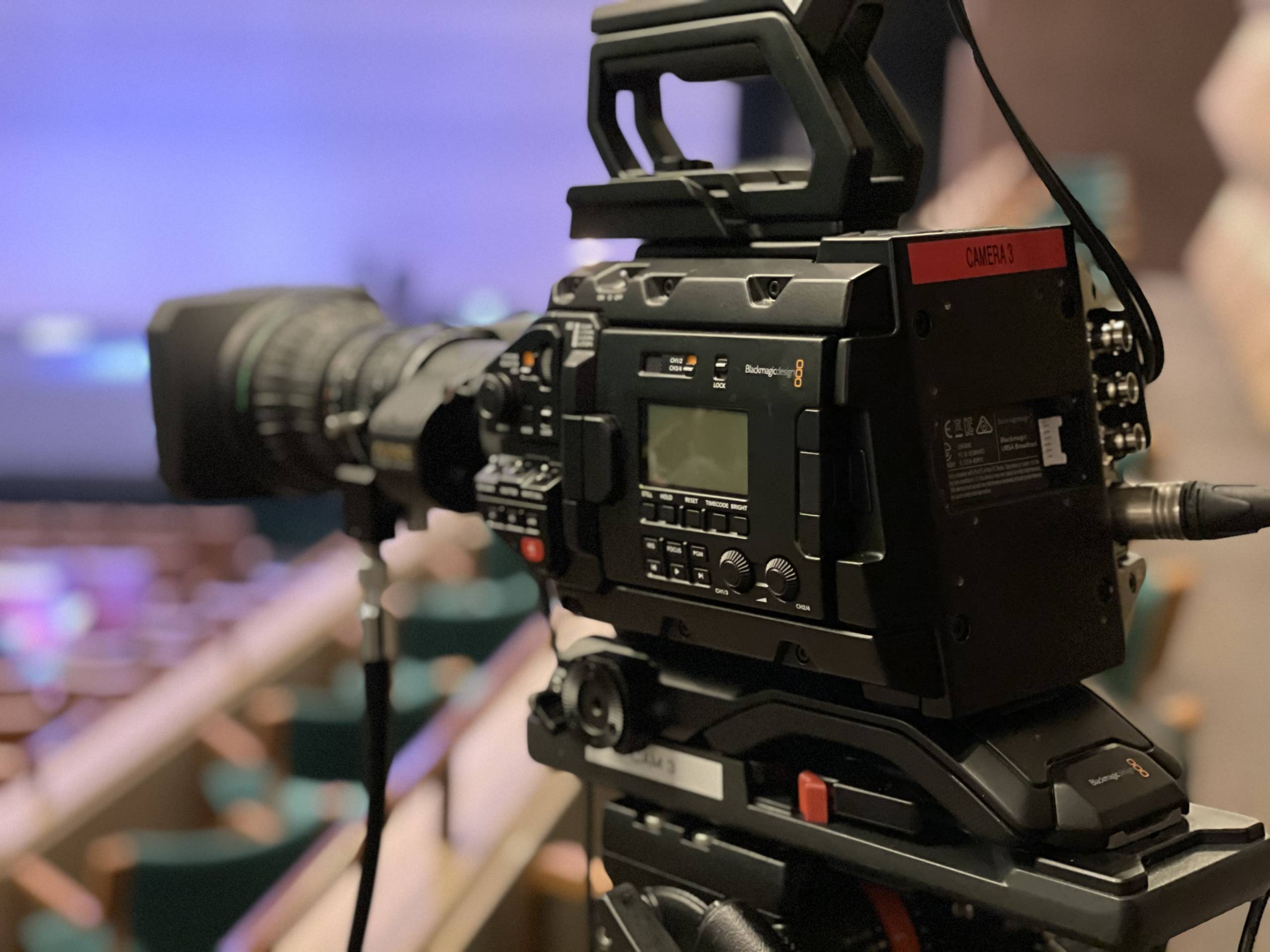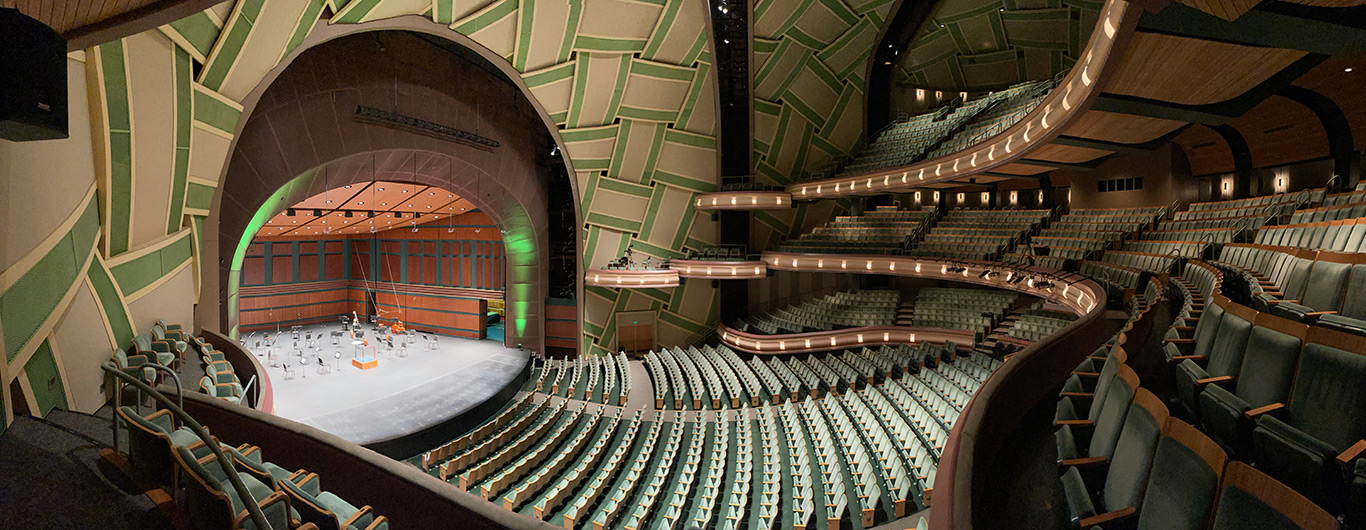After the final bow of Eugene Symphony’s exhilarating concert with Leslie Odom, Jr. on leap day of 2020, we never imagined it would be our last time on stage for a year. As the COVID-19 pandemic continued to impact our community, we knew we had to reimagine the ways we would make and deliver music this year. In response, we created Symphony Soundwaves, a series of free streamed virtual concerts for the 2020/21 season!
In February, updated COVID-19 guidance from the State of Oregon allowed us to return to the Hult Center for our Soundwaves recordings. Our return has been wonderful – and, anything but normal. With strict health and safety protocols in place and new state-of-the-art technology, it has taken countless hours and a dedicated team to learn how to produce the high-definition recordings you may have seen. If you haven’t watched a Soundwaves concert yet, you still have opportunities in May and June – all of which will be recorded in the Hult Center!

For a behind-the-scenes sneak peek, we asked a few of the many people bringing Soundwaves to life to tell us about their experience:
- Hult Center Assistant Technical Director Nathan Cox
- Eugene Symphony Conducting Fellow Daniel Cho
- Eugene Symphony General Manager Lindsay Pearson
- Assistant Principal Violin II Julia Frantz
What was it like being back in the hall?
Cox: The Hult team actually never left the hall during the pandemic! We developed a plan to keep a small work crew that would keep up with maintenance and upgrade projects. We kept the ship afloat and operational so that when we were able to allow people back, we would be in a good spot to swing open our doors and welcome artists into the building. We are grateful to be in this spot today and there are not many performing arts centers around the country that are in this ready position like we are.
Cho: It was so surreal walking back into the Hult Center; I really felt the scope of the change the world had experienced this past year. Above all, the emotion I felt most deeply was gratitude – gratitude for the music, the musicians, the Eugene Symphony team, the stage crew, the green velvet seats and the beautifully curved wooden panels on the mezzanine. I don’t think I’ll ever forget the feeling.
Frantz: It was wonderful, nerve-wracking, thrilling, and heart-warming! After a year of not being able to play together, it was incredible to come back, see my string colleagues, and make music together again. Playing with other musicians is something I have missed so much during the pandemic. It was also kind of stressful, and I think everyone felt a little rusty. I worried that, over the course of the last year, I had somehow forgotten how to count and play in an orchestra.

What challenges did you have to overcome for these recordings?
Pearson: Everything. It has been a roller-coaster of a year with so much uncertainty. It felt like every time we were able to make a plan, something changed, and we had to start all over again. But getting back to the hall, being around live music again, knowing we can share free concerts with the community, and witnessing the talents of these wonderful musicians with whom we are fortunate enough to work—the frustrations and heartbreaks of the last year started to melt away.
Cox: The challenges we continue to overcome are mostly technical issues. The skill of operating professional cameras, shading, switching and robotic cameras is a whole new animal that can be difficult to master. But many elements of the stagehand craft are similar. I have been very impressed with our camera operators using many techniques learned from years of spotlight operation. For example, when you see a spotlight appear on an artist onstage, you see a nice glowing circle around the performer as they grace the stage. What you don’t see, is the giant heavy spotlight equipment that takes two hands and half of your body to manage. Our same stagehands are using skills and tricks from spotlight operation and applying it to camera operation to capture the action on stage.
Frantz: The spacing distance between stands was the biggest challenge. Normally, we are used to having stand partners and being quite close together as a section. This helps us play together and interpret things the same way. For these rehearsals and recordings, we were each on our own stand and spaced 6 feet apart. This made it hard to hear each other and to stay together, both within sections and across the orchestra. Wearing masks while playing was also weirdly disorienting. A few times, my mask slid up almost over my eyes while I was playing, and there were no rests in the music to pull it down. Finally, it will always feel strange and stressful to play for cameras and an empty hall instead of a lively, warm hall full of audience members. The audience brings SO much energy and life. Everyone felt a little more on edge knowing we were making a recording, and at times it was hard to find that energy that a live performance brings. I can’t wait for the day when we can play for an audience again.

What was a moment that brought you the most joy during the rehearsals or recordings?
Cho: Working closely with Nathan Cox, we found a nice rhythm when directing camera work for the recordings. The moments that brought me the most joy were celebrating with him after we had really nailed capturing the performance of a piece. I learned a lot from Nathan, not only the technical aspects, but also in leadership – I watched him actively try to create a positive working environment for the crew, stay calm during stressful situations, and genuinely care about the work he was doing. I look forward to continuing to work with and learn from him.
Pearson: All of it. The enthusiasm of the musicians and Hult crew to be back in production, the adrenaline from long, fulfilling days, and the energy of the music. For so much of the year I have felt a bit lost at sea and while there have been little islands along the way, being able to return to the hall with a substantial number of our musicians felt like we finally found land again. The first week we were back at the Hult Center, one of the crew members told me they felt human again for the first time in a year. I couldn’t agree more.
Frantz: Seeing my colleagues and friends, many for the first time in over a year, brought me so much joy. Just the experience of having a rehearsal to go to and music to prepare. There was a moment back during our February set, at the very first rehearsal, when we started playing the Mozart Divertimento. I had been so stressed and worried for days leading up to this rehearsal – worried that I’d forgotten how to play and lead in a section, that I didn’t know what I was doing, that I would fail. As soon as we started playing that piece (which I love) and I felt and heard that full sound, I remembered the joy of making music and playing with others.
What should audience members pay special attention to, or what do you hope audience members take away from these recordings?
Cox: The specific goal is to tell a story with video and audio. Audience should look for the eye contact of musicians as they play and express the story to each other as it twists through love, hate, passion, dread, loneliness and hope. There is much to explore seeing a symphony up close, loads of expression from the musicians and especially from maestro Francesco. I am certainly proud to help visually publish this story.
Cho: We took this opportunity of recording to try and show elements of an orchestral performance that people wouldn’t normally be able experience, even in a live setting. What does Silva Concert Hall look like from the musician’s perspective? What does the conductor’s face look like during this particularly emotional moment in the music? How does the percussionist create that specific sound when playing the tambourine? This was something our Executive Director, Scott Freck, really emphasized and once the team internalized it, the recordings found an identity that I think viewers will find really engaging and exciting.
Pearson: These programs are just incredible and really have something for everyone. There is joy, love, horror, ecstasy! I’m a sucker for slow movements, so the second movements of both Grażyna Bacewicz’s Concerto for Strings and Edward Elgar’s Serenade I found particularly wonderful. I could get lost in those pieces for some time and be quite happy about it. On the other end of the spectrum, Dmitri Shostakovich’s Chamber Symphony is a work that I found to be very cathartic—it so brilliantly expresses devastation and terror that so many have been feeling this last year. To me, one of the most powerful things about music is that hearing the expression of someone else’s emotions, be it joy and love or loneliness and desperation, reminds me that we’re not alone in what we may be feeling. I have always found that to be a powerful source of hope and strength.
Huge thanks to the Hult Center for inviting Eugene Symphony as a guest writer on their blog. Find more behind-the-scenes content on social media. Follow us on Facebook and Instagram: @eugene.symphony
Be sure to tune in for Eugene Symphony’s final three Soundwaves virtual concerts this season, premiering on May 6, and June 3, both at 7pm PDT. Learn more at eugenesymphony.org

